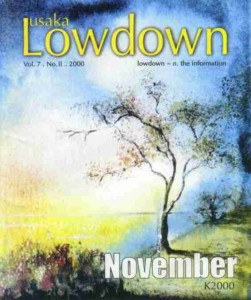 There are some countries, with their well-stocked art galleries and museums of various types, which literally seem awash with art. Zambia is not one of them. But by the same token, at least in Lusaka, hardly a week seems to pass without there being some sort of art exhibition. And Zambian works of arts can now be found in hotels, banks, government and other public buildings, and recently have been proudly displayed at an international conference hosted by Zambia.
There are some countries, with their well-stocked art galleries and museums of various types, which literally seem awash with art. Zambia is not one of them. But by the same token, at least in Lusaka, hardly a week seems to pass without there being some sort of art exhibition. And Zambian works of arts can now be found in hotels, banks, government and other public buildings, and recently have been proudly displayed at an international conference hosted by Zambia.
This has prompted many to ask if art, for so long disregarded , is finally getting its due? Says a local art critic “Before independence and after independence art, together with music was regarded as a past time. Now the public has started, in a small way, to appreciate our local art.”
This new appreciation which translates into more buyers for art, has led to the creation of a fairly recent phenomenon in Zambia: the artist able to earn a living through art. Of course they are only a few and Zambia still has its fair share of artists struggling to make ends meet and those obliged to support themselves from a wide variety of other occupations.
In this light things look bleak for the artistic community but cast your mind back few decades when hardly anybody could live by the brush or chisel alone and you realise it is a positive change; albeit a very small one.
Flinto Chandia, a leading local sculptor, with numerous exhibitions under has belt and one of Zambia’s full time artists, believes there is a lot more Zambians could do to improve the lot of the artist. He says increased patronage by Zambians is essential in stimulating artistic efforts.
The current scenario is that the largest buyers of artists’ work are diplomats and expatriates. While pleased with the attentions of these buyers Chandia says the benefits the artists derive from these buyers could be enhanced by increased Zambian patronage.
And he says the issue of price does not come into it, as works of art range in prices. He says local works can be quite affordable but a lot of Zambians prefer to spend their money elsewhere. He recounts with pleasure how pleasantly surprised he was whilst participating in a major African art exhibition in London to observe that Nigerians in London would come and buy works by modern Nigerian artists. And indeed a recent study on African art noted that it is becoming fashionable and prestigious for Nigerians to display modern Nigerian art in their homes.
He says you can’t force Zambians to buy works of art, but you can encourage them. One way to do this he believes is by educating them on the country’s local art.
“There are more Zambians who have started coming to exhibitions and if many more come this can be a great help to arts in Zambia. There is money around locally and Zambians need to be educated concerning the value of their art,” says Chandia.
Many art lovers in the country believe this is a role well suited to a national art gallery. They argue that a national gallery would stimulate a greater interest in art and knowledge of this important area of creativity could be greatly enhanced primarily through a national gallery that displays the diversity of modern Zambian visual culture. As the country’s premier art institute it would not only showcase the best talent available in the country, but would also give a fair representation to all the modern and talented Zambian artists.
Unfortunately the idea of a national gallery doesn’t seem to be getting the attention it deserves. It is a much talked about idea, but nevertheless it remains an idea.
Gaudenzio Rossi, patron of the Visual Arts Council, a body set up to promote the arts, and major Zambian art collector, believes such a gallery is essential for the well-being of the arts. He says measures to give space to art in the country’s museums while welcome, are not adequate. He says it’s essential for Zambia to have a gallery dedicated purely to the arts that would show, in a profound way, the diversity of Zambian creativity in the mediums of paintings and sculpture.
“We’ve been talking forever about a national art gallery. All the paintings sitting in store rooms should have a home. And the government should help by buying paintings and displaying them” says Rossi.
“If we want to keep the history of Zambia alive, we need a gallery where the works of art can be displayed. Art is part of the history of Zambia and where else do you display your identify publicly if not in a public gallery?”
By Jifipa Ngalande
Leave a Reply
You must be logged in to post a comment.